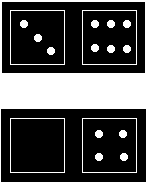 46. AS QUIET AS A DOMINO
46. AS QUIET AS A DOMINO 
A domino is a black tile made up of two squares, with sunken white dots. The dots on each of the squares represent one of the digits 0 to 6, and every possible combination occurs just once in a set of dominoes.
How many dominoes are there in a set?
If the whole set of dominoes is placed end to end in a straight line so that neighbouring squares of adjoining dominoes match (e.g 1–6, 6–3, 3–2, ...), can you say anything about the two digits at the ends of the chain? Why does this happen?
Suppose now we remove all the dominoes containing a six (including the double six). Can you arrange this smaller set in a single straight line as above? What is happening here?


Hint 1
If you have a set of dominoes, experiment to see what results you might expect to get.
Hint 2
How many times does a given digit appear in the complete set? What is the effect of pairing?
Solution
There are three questions to be answered here.
How many dominoes in a complete set?
The answer is 28. First of all there are 7 doubles: 00, 11, ... , 66. Then as well, there are all the dominoes which have pairs of different digits. The number of ways of choosing two distinct digits from seven is
7C2 = (7 x 6) / (1 x 2) = 21,
giving a total of 7 + 21 = 28.
What happens at the ends of a chain of a complete set of dominoes?
In a complete set of dominoes, each digit occurs 8 times. In the forming of the chain, equal digits are placed together, and so ‘removed’ in pairs. Hence the digits at the end of a chain must be equal.
What happens when we try to form a chain of the smaller set of dominoes?
Since all the sixes are removed, this set contains no sixes, and there are exactly seven occurrences of each of the six remaining digits. We deduce that in trying to form a chain, it is impossible to match them all in pairs. Thus it is impossible to form a chain with this smaller set.
Extensions
1. Try some other variations. For example, what happens if we form the smaller set by removing all the fives and sixes?
2. Parity (pairing) arguments are very powerful. For example, two opposite corner squares are removed from a chess-board. Assuming that a domino covers exactly two squares, is it possible to cover the board with (sufficient!) dominoes?
Hint 1
Hint 2
Solution
Extensions


